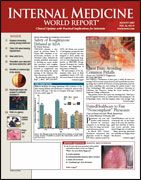Publication
Article
Internal Medicine World Report
High Ranking No Guarantee for Best Outcomes in Acute MI
Author(s):
By Rebekah McCallister
Patients with myocardial infarction (MI) admitted to a hospital ranked as one of "America's best" by U.S. News & World Report are less likely to die within 30 days than if they were admitted to "nonranked" hospitals, yet nonranked hospitals with favorable mortality ratios outnumber ranked hospitals with similar performance by nearly 3 to 1, based on a new study (Arch Intern Med. 2007; 167:1345-1351).
"The rankings, which include many of the nation's most prestigious hospitals, did identify a group of hospitals that was much more likely than nonranked hospitals to have superb performance on 30-day mortality after acute myocardial infarction," said coauthor Harlan M. Krumholz, MD, the Harold H. Hines Jr Professor of Medicine and Epidemiology and Public Health at Yale School of Medicine. "But our study also shows that not all ranked hospitals had outstanding performances and that many nonranked hospitals performed well."
The 30-day death rates for 13,662 acute MI patients in the 50 U.S. News & World Report?ranked hospitals for "heart and heart surgery" were compared with rates for 254,907 patients with acute MI in 3813 nonranked hospitals. The study methods were similar to the recently released mortality measures publicly reported by the Centers for Medicare & Medicaid Services. The hospitals' standardized mortality ratios were compared, with a ratio of >1 indicating more deaths than would be expected and a ratio of <1 indicating fewer deaths than expected.
After factoring in patient characteristics, the 30-day death rates, on average, were lower in ranked hospitals than in nonranked hospitals by about 2%. When the hospitals were divided into 4 groups based on these rates, about 70% of the ranked hospitals were in the group with the fewest deaths, 22% were in the middle 2 groups, and 8% were in the worst-performing group.
U.S. News & World Report
The study also showed that 22% of ranked hospitals and about 1% of nonranked hospitals had standardized mortality ratios significantly less than 1. The lesson from this study is that the ranking list does not include many hospitals that have outstanding performance for the care of MI patients.
In an accompanying editorial (pages 1342-1344), Sean Michael O'Brien, PhD, and Eric D. Peterson, MD, point out that the only system that captures acute MI results among all US hospitals is Medicare data. "Such claims (billing) data cannot assess results in those older than 65 years or accurately identify clinical risk factors associated with mortality," they write.
More important, they note, even if mortality rates could be flawlessly risk adjusted, measurement of acute MI mortality rates within hospitals would "remain inherently variable owing to the small patient samples available at many hospitals."
The study investigators note that the methods used by U.S. News & World Report, which include a reputation component, may "explain why it does not discriminate more accurately based on AMI [acute myocardial infarction] mortality rate."
This "reputation component," which accounts for one third of the overall ranking in U.S. News & World Report, is based on cardiologists' opinions. Thus, it may lean toward tertiary centers that offer specialized care for the critically ill and discount the care received by the lion's share of admissions for more common conditions, which has a much greater effect on overall hospital outcomes.
"Given the disproportionate influence of reputation, even relatively large mortality differences in this higher tier of ranked hospitals may be a less important factor in determining the overall ranking," they note.





